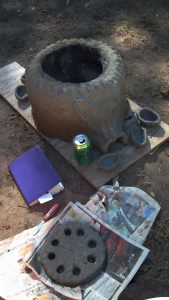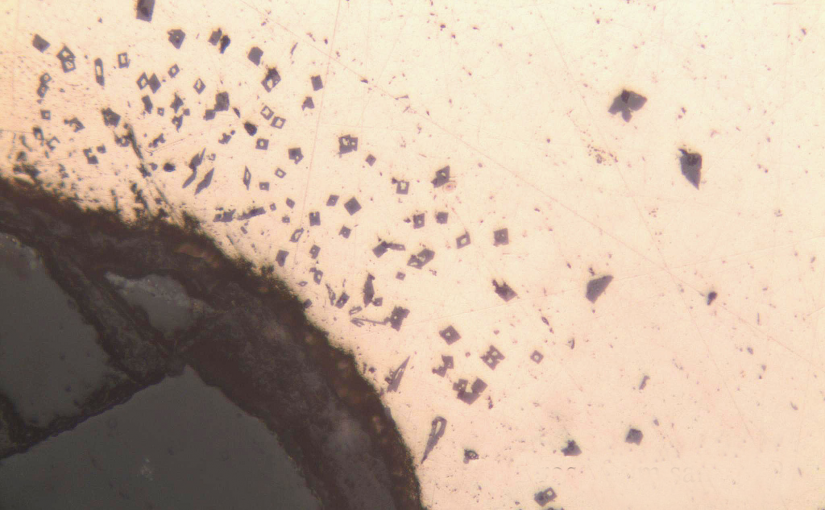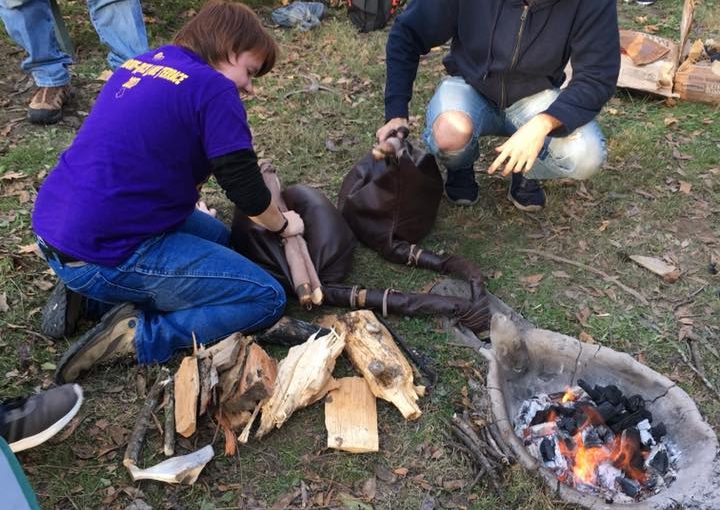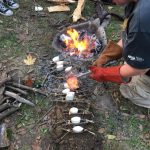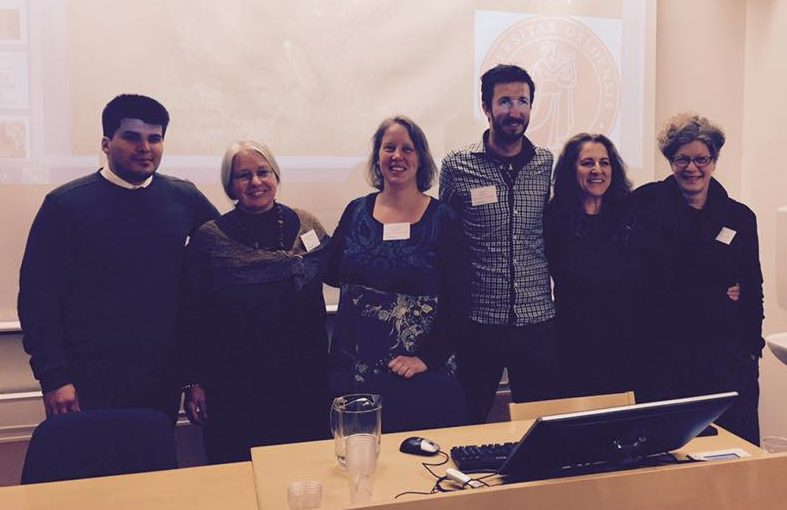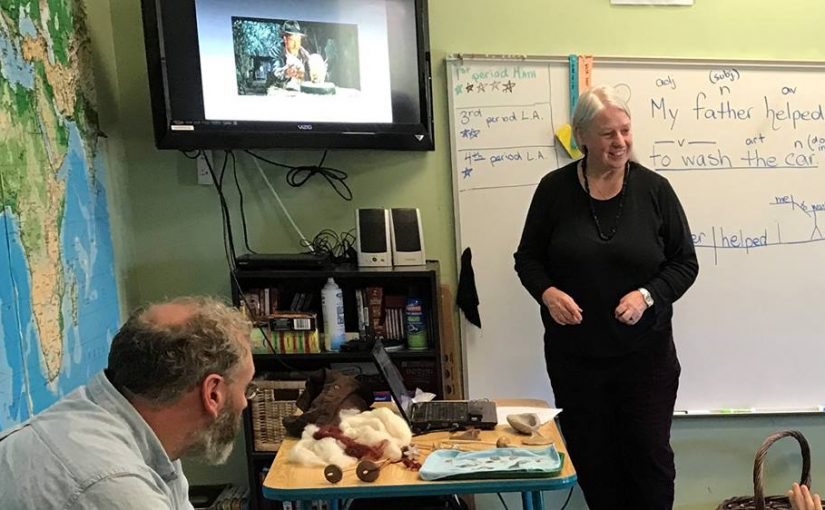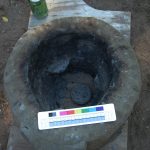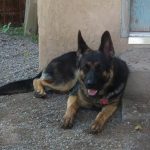Back in my undergraduate days we learned about Iron Age torcs. They were massive golden things, symbols of power and prestige. What exactly that power was, we didn’t know. They were made, used, and buried in the ground by people who had no written record. Our assumptions about power rested mainly in our own sets of values. But they are gold, valuable, and precious. Then there are other things that are just as valuable and precious, but more intangible…
A few years ago Tess Machling contacted me. She knew me as a jeweler/metalsmith turned archaeologist who had a passion for hammers and manufacturing processes. She had some photos and asked me what I thought. No details, just a question about what technique I would use to make something, or what would have caused this sort of mark. I enjoyed the puzzles. I told her how one photo was of metal that had been cracked because the smith had hammered it too much and the metal was fatigued. Could it the result of casting? No, the edges were too sharp, a casting flaw wouldn’t have a crack formed like that. In a few days I’d learn that other metalsmiths she asked told her the same things. She and Roland Williamson, a metalsmith with a background in making museum replicas, were searching for answers, and questioned everyone they could contact. Eventually I learned that we were corresponding about Iron Age gold torcs. The questions she asked us were set up like a blind test to avoid any bias. It was accepted knowledge that torcs were cast in gold and in the course of her research she was coming to the realization that the accepted knowledge was wrong.
The problems with institutions is that they lumber along and have difficulty changing. Even if they want to change, it occurs slowly. Most of the torcs were excavated and interpreted by antiquarians and archaeologists who never worked with metal and never thought to talk to someone who did. In my own research, time and again I came across ‘facts’ that had been passed along from one publication down the line that were just plain wrong. Tess and I both knew what she was up against. The entrenched ideas of institutions and people who uphold them are just as precious as gold. To have these ideas questioned seemed as great as affront as taking the One Ring from Gollum and declaring that it would be thrown into the fires of Mount Doom. But sometimes ideas do need to be cast away. Not randomly, but through careful research, examination, experimentation, and always questioning. I know that early on Tess did have doubts, but she and Roland had so much hard evidence that it was impossible to accept the status quo. Their hard work is changing the way we understand how Iron Age torcs were made. By examining tool marks they are identifying different techniques and seeing the smiths’ hands at work. They have found repairs, retrofits, and an entire catalogue of metalworking tricks of the trade.
In the course of their work, they have published articles in the The Proceedings of the Prehistoric Society, The Journal of the Historical Metallurgy Society, and the Later Prehistoric Finds Group Newsletter. But research is never static, it is something that is forever evolving and growing. As we all learned through this process, entrenched knowledge is terribly difficult to dislodge, even when it’s been proven wrong. There is also a need for transparency in research, and a way for the public to learn and participate in the process, free from paywalls. By producing their new website and blog, The Big Book of Torcs, Tess Machling and Roland Williamson are presenting their work for everyone to read, and question. It’s a wonderfully informative publication with a good bit of humour that will be useful for both the layperson and the academic, not to mention aspiring metalworkers!
Tag: experimental archaeology
Ever wanted to know about ancient beer and brewing?
There’s a new podcast by The Prehistory Guys featuring my friend and fellow EXARC member Merryn Dineley, an archaeologist who specialises in ancient brewing and especially the process of malting. I’ve had some of the brews she’s made and will say that the ancient recipes produce some fine beer.
There’s a lot of useful information here for both brewers and archaeologists. She takes down some of the misconceptions about the old beer/bread debate, and tells us how not knowing the brewing process has led to some misidentification of archaeological features.
So open up a favourite beer, relax, and enjoy it while learning about its long and fascinating history!
Stories from Times and Epochs, Moscow
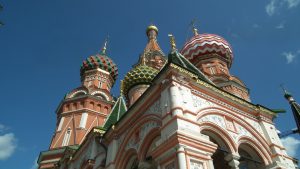
I have a Patreon page where I post stories about my travels and experiences casting bronze around the world. Last year I was in Moscow for the Times and Epochs festival, casting bronze with local reenactors. I learned a lot, both about different ways to cast bronze, and also about Moscow and Russia. The story is being told in installments. The first two can be found here:
If you’re interested in reading more, there are both public posts and ones that are available to my Patreon subscribers. There are also other benefits for supporters, including copies of powerpoints and articles, or even postcards sent from wherever I travel. Check and out my Patreon page here and consider a small contribution to support my ongoing work in experimental archaeology.
Vounous Symposium 2019
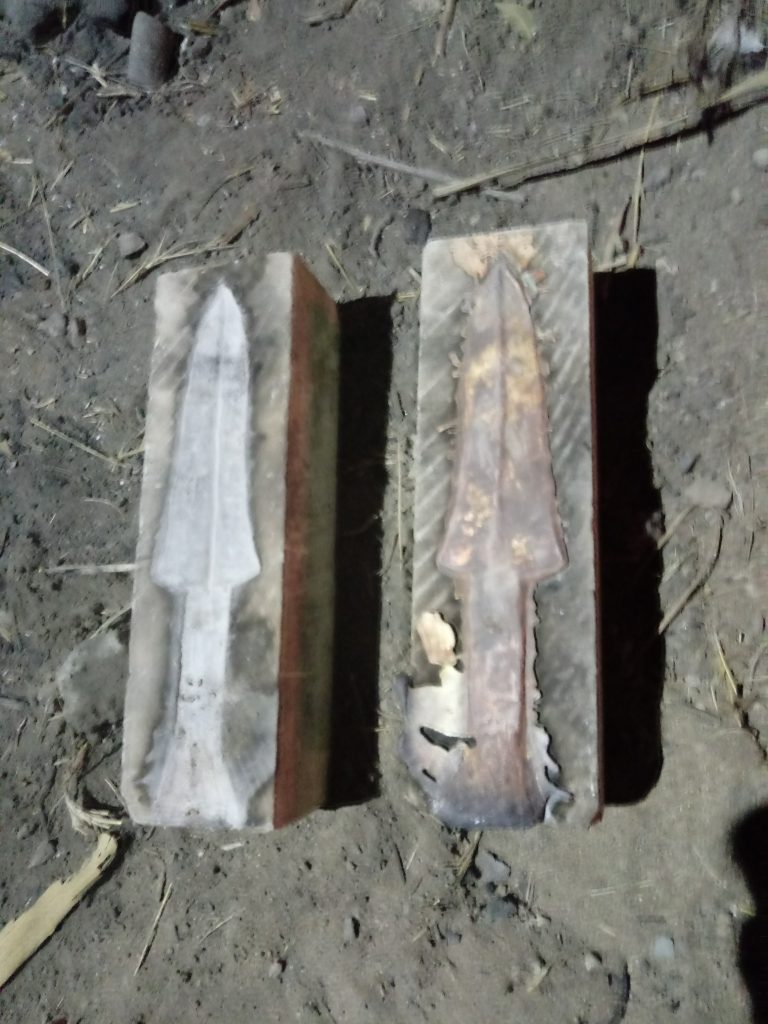
The 3rd Vounous Symposium went wonderfully well. We experimented with creating faience, including making it from locally resourced materials, resulting in what was named Vounous Blue. This year we had three furnaces, my little pit furnace from last year, one that is self drafting and one short shaft furnace. The self drafting one was used for the faience and small projects. It didn’t get quite hot enough for some things we needed, but the design was a work in progress. The shaft furnace was supposed to be for smelting ore. We had a couple of nice samples, but when we went to collect more, we found that the site was under water. Local members of Vounous will go back when the water is down and will collect more. Meanwhile we used what we had to make the pigment for the faience and smelt in a crucible. Since we had so little, we saved it for the evening of the closing ceremonies. People were impressed with the bright blue flames.
Chris, of Maunfactum Historicum carved limestone moulds for us to cast in, making replicas of knives and daggers that were excavated in the vicinity. He also carved an impressive Egyptian kopesh. We didn’t get that cast, but will try for next year. We wondered about the limestone because we’d always been told that it wouldn’t work. However the moulds we’d seen were local limestone, and we found that this worked very well. Apparently not all limestone is created equal.
The above photo is a replica of a dagger we saw at the Museum of Archaeology and Nature, Gurzelyurt ( Morphou) in its limestone mould. We’ve also cast daggers that are replicas of one that was found here at Vounous.
I wrote a short article for EXARC about last year’s Vounous Symposium. You can read it here.
Crafting in the World: Materiality in the Making

Crafting in the World is a new work that combines the world of archaeology, craft, and anthropology. It explores crafts in ancient and modern contexts and discuses the relevancy of understanding crafts to other disciplines.
I had the privilege of writing one of the chapters for this book. In it I discuss how metal objects can be read in a way that the actions of the smith can be visualised.
"This volume expands understandings of crafting practices, which in the past was the major relational interaction between the social agency of materials, technology, and people, in co-creating an emergent ever-changing world. The chapters discuss different ways that crafting in the present is useful in understanding crafting experiences and methods in the past, including experiments to reproduce ancient excavated objects, historical accounts of crafting methods and experiences, craft revivals, and teaching historical crafts at museums and schools. Crafting in the World is unique in the diversity of its theoretical and multidisciplinary approaches to researching crafting, not just as a set of techniques for producing functional objects, but as social practices and technical choices embodying cultural ideas, knowledge, and multiple interwoven social networks. Crafting expresses and constitutes mental schemas, identities, ideologies, and cultures. The multiple meanings and significances of crafting are explored from a great variety of disciplinary perspectives, including anthropology, archaeology, sociology, education, psychology, women’s studies, and ethnic studies. This book provides a deep temporal range and a global geographical scope, with case studies ranging from Europe, Africa, and Asia to the Americas and a global internet website for selling home crafted items."
The link to the publisher is here. It is an academic publisher, and so it is rather expensive. However some university libraries already have copies, so I would recommend seeing if your local library can get a copy, or borrow it on Inter-Library Loan. If all else fails, contact me through the website or Academia.edu for a PDF.
Now we’re Cooking with Gas! How experimental archaeology challenges modern assumptions about metal recycling.
New article available through EXARC. See the link below for the full article
It is accepted knowledge that when re-melting alloys, some of the metal with a lower melting temperature is lost through oxidation, and more metal must be added in order to maintain the desired alloy proportions. In order to understand the changes in alloy content when recycling using Bronze Age technology, experiments were undertaken by the author and others, using a charcoal furnace. These experiments included recycling bronze to quantify the loss of tin, and how alloys were affected by co-melting metals. The results were then compared to modern metallurgical practices using electric and gas furnaces. The initial results were presented at the Historical Metallurgy Society’s Research in Progress Conference in November of 2009. However, this paper includes further experiments that build on the earlier work. The conclusions indicate that knowledge of earlier practices was lost with the advance of technology, and that broad assumptions cannot be made about earlier technological practice based on work done with modern equipment.
Read the full article here
Experimental Archaeology at Western Illinois University
On November 1-3, 2017 I was in Macomb, Illinois leading a bronze casting workshop at Western Illinois University. This was the first event of its kind for the University and few people there knew what to expect. While the archaeology program provides for a certain amount of flintknapping and some pottery done by students, there was no available program for the introduction of the method and theory behind experimental archaeology.
Professor Andrea Alveshere, a colleague of mine from the University of Minnesota and I discussed the possibility of my coming to give a short seminar and workshop. There wasn’t much in the way of funds for the project, so I agreed to come as long as my expenses and materials were covered. It was a program that both she and I very much wanted to introduce to the university.
I had a long train ride from St Paul to central Illinois, but enjoyed seeing the landscape. I arrived fairly late that evening and was taken to cabins on rural property now owned by the university. The land and cabins had been bequeathed to the university and they are a great resource. In addition to dorm-like cabins with bunk beds, bathrooms, and limited kitchen facilities, there is a dining hall with a complete kitchen. We made sure that there were supplies for coffee and breakfast and checked out the site where we would build the furnace.
The grounds around the cabin are level and grassy, and there was already a large firepit with picnic benches arranged around it. I met the site manager, and we chose a spot beyond the firepit where we could construct a small pit furnace. She was excited about the project and had no problems with holes being dug. She also liked the idea of the furnace being buried when we were done with it so that it could be excavated later.
We hit the ground running on Thursday. Andrea picked me up and we went to the university where I met students and staff in the art metals department. They were excited about participating in the project and were glad to provide us with supplies. The idea of primitive casting was fascinating to them and they looked forward to the event. I borrowed some tongs and other equipment from them, with more to be delivered the next day. While we spoke, one of the professors who teaches pottery came in. We needed clay, and I had to explain that we wanted his worst stuff, the stuff that’s scraped off tables that’s usually discarded or sent for recycling. He didn’t quite understand why we wanted the useless clay, but he said that we could have as much as we wanted.
After lunch we made a run into town for more supplies. We found bags of sand and proper lumpwood/natural charcoal at the local farm store for a reasonable price. The plan was to cast into cuttlefish bone since two days was not enough time to make moulds for lost wax casting. Andrea had ordered cuttlefish bone from a wholesaler, but unfortunately when the shipment of arrived it contained packages of aquarium gravel. So we were also scouring local pet stores for cuttlefish. Andrea contacted the company she ordered from and arranged an overnight delivery, but there were no promises that it would arrive in Macomb in time. The nearest FedEx office was in Peoria and it would have to go by post from there to Macomb.
We agreed to meet up at the site at 2:30 to build the furnace. When we arrived, a few students were already on site. I explained to them about clay mixing and the reasons we mix sand and dung with the clay. In the process they got a basic lesson about ceramic petrography, and early clay recipes.
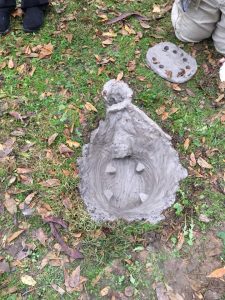
By the time we were done they had a working knowledge of clay bodies and the physical experience of working with it as well. A hole was dug and then it was lined with clay. I explained about tuyeres and used a branch to construct a clay-lined hole that ran from the top edge to the base of the furnace. When I build a furnace I usually ask the students to decorate it in some way. Usually something is put above the hole where the tuyere comes in. While working, the students decided that the furnace should have a turtle head above the tuyere. A nice choice, since the glowing charcoal would make for an interesting turtle shell! While they worked on that, I made the platform (also known as teapot stands or perforated clay slabs) to place in the furnace. By 6:30 pm we had everything done. That was right on time since I needed to change clothes for my talks at 7 pm at the university.
Once I was cleaned up Andrea took me to the lecture hall. It was a great facility with a large wall-sized screen and auditorium seating. It was almost half full, which was good considering that it was a weekday evening and the subject was unfamiliar to most people. Despite that we drew attendance from the anthropology and art departments, in addition to members of the local archaeology society and members of the public who were not associated with the university.
I gave three short talks in succession with questions and answers after each one. These were all presentations that I’d previously given at conferences, all of which were about 15 minutes long. I started off with the one I gave in Oslo about the significance of mistakes and how they are preserved in metalwork. The second was about Minimum Tools Required, a portion of my PhD thesis that organised the chaîne opératoire of metalworking. The final talk was about excavating metal, based on the BAJR guide that I’d written. The questions were enthusiastic and despite there being little in the way of prehistoric metal in the region, there was interest in the subject. I did answer a couple questions about Lake Superior copper use among Native Americans. There is some debate as to how some of the copper objects arrived in central Illinois from northern Minnesota. Were finished objects traded by Native Americans, was the raw material transported and traded, or was the copper a chance find of raw material that had been redeposited in southern Illinois by glacial action? I hadn’t seen the objects, but typology might provide a part of the answer. At the end I spoke a little about what we would be doing the next day.
Afterwards Andrea and I returned to the furnace. Although it was still damp, I wanted to get it dry before casting the next day. We laid a little fire and sat talking late into the night. The presentation had been a great success and it looks as if it generated a lot of interest.
Friday I was scheduled to give a talk on experimental archaeology at noon. This was basically an introductory lecture about why and how experimental archaeology is done, along with the basic ground rules for doing experimental work. Word had gotten out and the room was filled to capacity. After the talk we headed back to the site and got to work. Because we hurried the process along last night there were a couple cracks in the furnace, but because it was set into the ground the cracks had little effect. The furnace was still warm from the previous night and I used a trusty pig scapula to scrape out the ash and leftover charcoal and then fit the platform in place. The fire was lit and after I had worked the bag bellows for a bit, the students took over. Every group I work with seems to have a different approach as to how to operate the bellows. I know that the way I do it, alternating pumps with one per hand, is difficult to coordinate for many people trying it the first time. Some people never quite get it and just pump both the bellows at the same time (affectionately known as the Cambridge Method). Here, the students teamed up and had one person per side, operating the bellows with both hands. They were surprisingly well-coordinated. The students were energetic and worked long sessions without tiring. At times I had to ask someone to give up their place to let another student try. I wanted to make sure that everyone who wanted to (including non-students who had come to see what was going on) had a chance at the bellows. The furnace took a bit longer to get the first crucible of metal melted than it normally does because of the frequent changes of personnel pumping the bellows, but we did get there. About an hour after we started Andrea got the call that the cuttlebone had arrived. Students were already carving moulds from what we had on hand. Now things were in full swing. I was grateful to the jewellery professor who took on showing the students how to prepare and carve the cuttlebone while I supervised the melts.
There were a few failures due to improper mould preparation. It gave me the opportunity to explain how easy it was to lose droplets of metal while casting and pointed out the debris that was getting trampled around the furnace, tell-tale clues that an archaeologist needs to look out for in a site that could be mistaken for a cooking pit. Every experience that day was a teaching moment. Both instructional and non-discursive. Repeatedly students told me that they had never known that there was such a thing as experimental archaeology, and that they were thinking about archaeology in a new way. A couple students who had not yet declared were suddenly thinking about the possibilities of having a major in anthropology.
The students wanted to keep going despite a large pot-luck dinner that had been prepared, so we all went to eat in shifts. When I took a break, people assured me that I wasn’t too soot covered, although I felt as if I had charcoal smoke in every pore. The head of the Anthropology Department came up and complemented me on my lecture. He was impressed by how I presented the information and noted the enthusiasm of the students. The potluck was also attended by members of the local archaeology society who aren’t formally a part of the university, but attend functions and often work with students on projects. We had a great time talking about local archaeology and experimental work.
After dinner we worked a little more, but it was long past the time that we could see well in the dark. We packed up as much as we could find and put it all in the cabin.
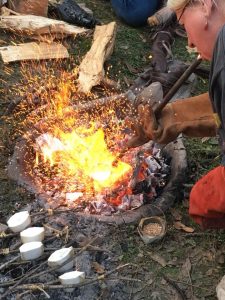
I had the choice of leaving on Saturday or Sunday. I opted for Sunday because the train left at 7 am and I knew that Friday would be a late night. I told the students that if they were interested, we could continue casting on Saturday. I had no lectures or other plans, so we agreed on a 10 am start.
The next morning we had another good-sized group of students. The previous day there had been close to a couple dozen people in the afternoon and rarely fewer than a dozen visiting throughout the day and evening. Saturday was more relaxed, but still well-attended. Students made moulds and instructed new participants who hadn’t been there the day before. The more experienced ones were already taking on tasks like they were old hands at it.
Andrea was amused that this was supposed to be my day off, but instead it was another full day of casting. Some experimentation was done with hammering (using my bronze hammer and anvil) and other finishing work. One student was keen on textile archaeology, so she cast some beautiful spindle whorls. I also made some clay ones with her, using some of the scraps left over from building the furnace. Once dry, she’ll take them to the art department to see if she can get them fired there. I heard that they also do raku pit firing.

Towards evening I needed to call it quits. I had an early start in the morning and needed to get things cleaned up and packed. The students reluctantly poured the last moulds and we got everything in order. The next day they would cover the turtle furnace with dirt and let it deteriorate. Left to itself, it should be covered in grass in a year. In a year or two it will be just as useful as a teaching tool for excavation.
The entire event was successful and exceeded our expectations. We had brought an entire new perspective on archaeology to the department, and the department heads were impressed. In my talk I had emphasised the value of programs like this not only for hands-on student learning, but also as a unique opportunity for public interaction with the department. Too often universities are segregated from the surrounding community leading to the local residents wondering what goes on there. Experimental archaeology programs, especially those performed out of doors, provide an opportunity for interaction and public participation, and even drawing on experience of people from outside the university. Andrea and I discussed the possibility of doing a longer workshop or even the possibility of an accredited short course. Now that the department has been given an idea of what can be accomplished, they might be more amenable to funding it.
These are ambitious ideas in a time when universities are hurting for money. I was glad to be a part of this mainly because I wanted to help Andrea introduce experimental archaeology to her students and colleagues. There was no budget for such an unknown project, but because we were keen on this, Andrea scraped what funds she could get at short notice and we put it together on a shoestring. I would love to pursue this and give students the full range of what an experimental archaeology course could offer, but that is for the university board to decide.
In the meantime, I would like to thank all the people who support my project on Patreon. They provided the opportunity for this seed to get planted and for students to have a unique experience that will benefit them in their careers as archaeologists. The contributions made through Patreon and PayPal go towards giving more people the opportunity to explore the world of material culture in a way they never realised before. If you’re interested in finding out more about my Patreon project or making a sustaining contribution please click on the link below.
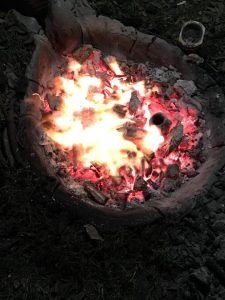
|
Did you find this information useful? Please consider supporting this site with a small donation through PayPal |
Nobody’s Perfect: Contrasts in Craft session at the Nordic Bronze Age Symposium
June 2017
It was my pleasure to present a paper at the Nordic Bronze Age Symposium in Oslo . The conference focused on contrasts and connections in the Bronze Age. Presenters covered a wide range of topics from landscape, technology, social practices and materialities.
The session that I participated in was titled Nobody is Perfect: Contrasts in Craft. I spoke about recognising the learning process by examining mistakes in metalwork. It was a great session and I hope that the research presented here will spur others to examine the flaws in objects to understand the processes of craft production.
Too often artefacts are selected for examination and display because of their perfection, but perfection can limit us. We see the end product but by the very process of achieving perfection the traces of the journey to mastery are erased. When we examine flaws, both minor and major, the world opens up.We can follow the movements of the artisan’s hands and see the sequence in which an object was made. We can see the choices made during production. Was there a flawed section of decoration because a master artisan was momentarily distracted, or was it because an apprentice was still awkward using tools? We can also question why the flaws remain; why the object survives, rather than having been destroyed or repaired.
The flaws, repairs, and mistakes all contribute to the object’s biography and allow us a glimpse of craft and decoration in ancient cultures. The papers presented in this session examined these and more subjects on mistakes in craft, and generated lively discussion.
“Nobody is perfect: contrasts in craft – for the first time at an archaeological conference artists, craftspeople and archaeologists gathered together to discuss the potential of mistakes, failures and repair within material culture of the past. The results were stunning: mistakes, failures and repair can not only help to identify skill level and apprenticeship in craft, they also indicate the intention, the actual purpose of an artefact.” – Heide W. Nørgaard
Talking archaeology at Cyprus Classical Academy
Talking archaeology at Cyprus Classical Academy
In March 2017 I had a great time talking to the students at Cyprus Classical Academy about what archaeologists do. Cyprus Academy is a Montessori school in which classes are organised by ability rather than age. The students I spoke to ranged in ages from 6 to 11. This is a great age for kids to learn about prehistory and the fascinating story of how people invented tools and developed crafts. The students had a chance to look at and handle artefacts, pump a set of bag bellows, and have a go at using a drop spindle to spin some wool. They will continue on studying prehistory and history, but I doubt they’ll ever think about ‘cave men’ the same way again. Apparently one of the teachers was amazed by finding out that Neanderthals made flutes and had music.
One of the unexpected benefits of my talk was that a girl in the class was excited to know that there are women archaeologists. There is the popular perception that archaeologists are men, and while field archaeology tends to have more men excavating, I pointed out that women also excavate, and also work in labs and museums. I included some slides showing kids volunteering cleaning finds, to let them know that there’s a place for them in archaeology too.
The Mavis Furnace or how to build a furnace for almost no cost!
I was visiting my sister in the autumn of 2016. She has a bit of land just outside Albuquerque, New Mexico, so I asked her if I could build a furnace and do some casting there. I’ve built plenty of pit furnaces, so this time I wanted to build one that was above ground and a bit more visible. It would also mean that no one would trip and fall if they forgot where I put the thing.
The first task was to get the basic materials: Clay, Sand, and Horse Manure.
I thought that the clay would be the biggest hurdle. However my sister’s neighbour happened to be a sculptor who works in both iron and ceramics. She went to her regular clay supplier and got a couple feed sacks full of dried clay for free. Potters who work at wheels, or work with students end up with a lot of clay that is scraped off of workbenches and wheels that is hard to re-use. It often has a mixed consistency, it’s lumpy or part dried. If they want to use the clay again, it has to be reconditioned. So, they take their sacks of scrap back to the place where they buy the clay and pay to have it put through the mill. Since it’s not really usable, some potters are willing to just give it away. So thanks to Liz Fritzsche, who does amazing and beautiful work in porcelain, I was able to get started.
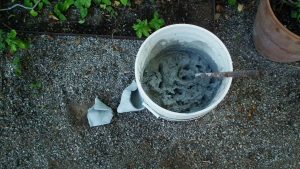
I threw some of the dried clay into a five gallon bucket and poured in enough water to cover the clay and let it sit. It was squishy and workable in a few hours. Next up was locating horse manure. A friend of a friend has horses, and they were grateful to have someone who would haul away a couple of barn buckets full of manure. The final bit was the sand. My sister did have some beach sand that she’d bought for the garden, but I was more fascinated by the soil there. Her land is in the old Rio Grande River Valley, and the soil is a mixture of silty sand and a little clay that had been pounded to a powder. The soil was almost the consistency of dust. It mixed in perfectly and later I found the mixture was highly resistant to cracking.
The ingredients were mixed with some water, stomped, and the proportions were adjusted until it was perfect. New Mexico is a lot drier than England, so I ended up adding more water than usual as I worked. It was also nice knowing that it was unlikely for any rain to fall while I was working.
The silt/clay/dung mixture made a durable clay, and after I flew back to Minneapolis, I was please that the crucibles and moulds I packed in my check-in luggage survived airport handling.

The furnace walls are about 8 cm wide (about the width of my palm) and the inside diameter is about 25 cm in diameter. I let it dry for a couple days and then moved it over to an unused area behind a greenhouse where I would have more room to work. I set a small fire with cottonwood branches, fed it for a couple hours, and then let it die out overnight.
We all like to put some decoration on our furnaces. My students have done everything from dragons to turtles to cats. I had been thinking about doing some decorations imitating the local petroglyphs, but as I was working it just seemed natural to do a portrait of Mavis, my sister’s exuberant German Shepherd.
Finally I adjusted the mix to have a bit more of the silty sand and horse dung to make the teapot stand and crucibles. For more information about teapot stands and how they work in furnaces, check out my article on the Umha Aois website here.
Later I added more water to make the slip for dipping waxes in for the first stages of mould making. The silt made a wonderfully fine mould that picked up all the details. Honestly, this mix was as good as jeweller’s investment for picking up detail.
I had some cracking on the upper part of the furnace, and noted that the part that cracked was where I used the commercial sand. The silty New Mexico soil held up much better. If it weren’t so heavy (and probably not allowed) I would have hauled bags of the soil on the plane home to use for more projects.
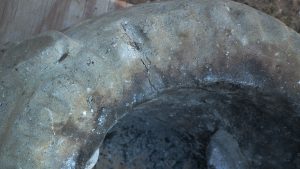
Both Mavises performed very well (Mavis the Dog is into barrel racing and advanced obedience classes). I’ll be interested to see how it holds up over the winter. Winters in New Mexico tend to be mild, so I’m hoping that the Mavis furnace will be available for friends in Albuquerque to use for some time to come.
